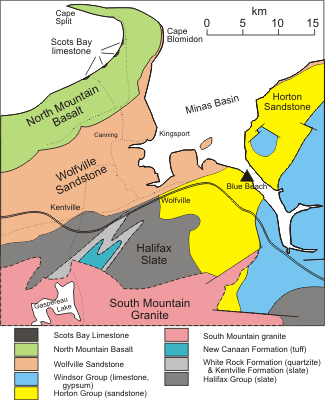Geology of the Horton Bluff Formation at blue beach

By J.A. Colwell & S.A. Ferguson
LOCATION - Blue Beach, on the western shore of the Avon River, accessible except at the highest tide times. Approximately 15 km from Wolfville.
ROUTE - From Wolfville go east on Highway 1 (Main Street) to interchange 10. Continue eastward on Highway 101 to exit 9. Follow the exit road to the stop sign on the Oak Island Road junction. Follow the Oak Island Road northward, crossing over Highway 101, for about 500 metres to the junction with the Bluff Road. Follow the Bluff Road about 3.5 km to the Blue Beach Road. Follow the Blue Beach Road, parking just after passing under the railway, and walk on the continuation of the road to the beach. This portion is usually in poor condition for driving.
At this location is the Blue Beach Fossil Museum - a privately owned collection of local fossils. Inquire locally for access.
DESCRIPTION - At low tide almost continuous bedrock exposure in the shore and cliff extends northward for 1500 metres from the Blue Beach Road to the Horton Bluff lighthouse. These rocks belong to the Middle Shale Unit of the Horton Bluff Formation of Early Carboniferous age. The Horton Bluff Formation unconformably overlies the Halifax Formation and is usually conformably overlain by the Cheverie Formation, although south of Blue Beach the Cheverie and Horton Bluff are in fault contact. The Middle Shale Unit is considered to be a lake deposit and consists of dark coloured laminated and unlaminated silty shale and siltstone with inter beds of dolostone and sandstone. The insoluble content of the dolostone ranges from 10 to 75 percent. The soluble carbonates consist of calcium, magnesium and iron with a small amount of manganese. Some dolostones are laminated and fossils are generally absent. Many sandstones are ripple marked and bases of some beds have grooves, flutes and raindrop impressions. Mud cracks in the shale are filled from the top down but in addition there are clastic dykes. Filling of the dykes from below is caused by the pressure of water and gas escaping upward through a crack in the overlying bed. Sedimentary collapse structures located on the foreshore about 1300 metres north of the lighthouse may have been produced by the same process. They range in diameter from 1 to 15 metres, and are thought to have been produced by liquefied or gas-charged sediment escaping upward through a vent, resulting in a dome-like structure.
Fossils found at Blue Beach include ostracods, fish scales, fish impressions, plant remains and small spores. Trace fossils include an intricate pattern of worm burrows seen on the base of a sandstone bed and formed as a cast of the underlying mud. Trails of tiny arthropods and amphibians are preserved on the bottoms of sandstone or dolostone beds. Bones of amphibians include two femora, a humerus and a skull cap and from this collection it has been concluded that the animal was fully adapted to terrestrial locomotion. The amphibian tracks are the oldest in the Western Hemisphere with the exception of Greenland. William Logan, later of the Geological Survey of Canada, visited the site in 1841 and found some fossil footprints, which he exhibited in England the following year. The footprints that he discovered were about two centimetres in width and slightly more in length, with three large toes and a smaller one on each side, and have been named Hylopus logani. From the centre line of a track to the centre line of an adjacent track on the opposite side the distance is about eight centimetres and the length of the stride is about 20 centimetres. Since that time trackways of larger amphibians with a pad of six to eight centimetres in width with a thumb have been found. These tracks are believed to be kick marks made by a floating animal. The amphibian bones and much of the fish material were collected in the cove directly below the Horton Bluff lighthouse, and an upright section of tree containing a bone was found here as well.
Prepared for the Geological Association of Canada and Mineralogical Association of Canada Joint Annual Meeting in Wolfville, Nova Scotia. May 25-27, 1992; meeting hosted by the Atlantic Geoscience Society.
